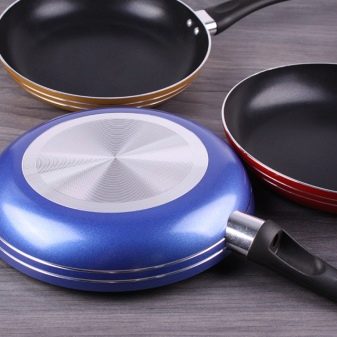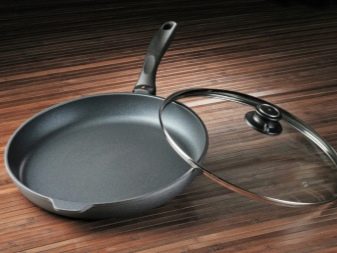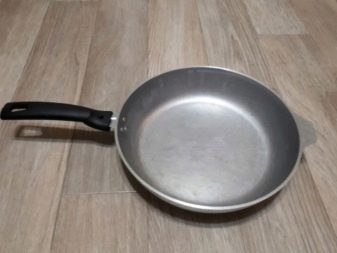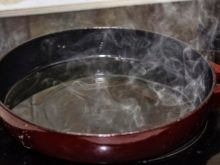Aluminum pans: pros and cons, selection and preparation for use

Aluminum is one of the most common materials used to make cookware that is directly thermally exposed. Frying pans belong to such dishes. Many housewives want to acquire such pans., but they doubt exactly what their advantages are, how to choose them correctly among all the variety presented on the modern tableware market. Before buying a frying pan made of aluminum, it is important to know both the criteria for choosing this utensil and the features of its preparation for use. All these issues will be discussed in detail in this article.


Peculiarities
The material for making a kitchen appliance such as an aluminum frying pan is food grade aluminum. A feature of this metal is the formation of a special protective layer when interacting with oxygen. This layer protects the device from corrosive processes and other unwanted chemical reactions, for example, the effects of various acids. Since this metal has a fairly high level of thermal conductivity, it is used as a raw material for creating pans.
The composition of such dishes usually includes not only aluminum, but also an additional material, from which a special coating is made, which prevents food from sticking to the surface of the pan.

Manufacturing of an aluminum frying pan can be done using a special stamp. For this, a necessary piece is cut out of a thin sheet of metal, from which the product is subsequently stamped. A distinctive feature of the result is the same thickness of the bottom and sides of this pan. It is not particularly resistant to high temperatures, so it is better to use them on electric type stoves, and not on gas ones. The cast technology for making aluminum pans is more perfect. When using it, raw materials are poured into a special mold, while the mold is designed so that the bottom of the product is quite dense (more than 0.5 cm).
Due to the balance between the thinner walls of the device and the thick bottom, the food is heated evenly, while the pan is resistant to direct fire.


Advantages and disadvantages
Before choosing an aluminum frying pan, you need to take into account that such cooking appliances have both positive and negative sides. The advantages of an aluminum product include the following:
- quick heating - you do not have to wait long before heating such a frying pan;
- such material, especially cast structures, is quite resistant to mechanical stress; even dropping such a pan on the floor, you will not damage its body;
- a useful function is heat preservation - designs with a thicker bottom allow cooked food to stay warm for some time and eliminate the need to reheat;
- in combination with a suitable coating, cast pans can serve for a very long time, which will save you money; if the coating is not sufficiently wear-resistant, this will adversely affect the condition of the device as a whole;
- a good coating allows you to heat such pans up to +400 degrees, in them it will be possible to cook any dishes both on the stove and in the oven;
- the appearance of rust on such dishes is completely excluded, which explains the special properties of this metal when interacting with oxygen;
- aluminum does not belong to porous materials, so it is quite easy to remove various kinds of pollution from it; in combination with some coatings, such pans can even be washed in the dishwasher;
- Cast aluminum products can be used on all types of stoves - gas, induction or electric.




The disadvantages of such utensils for cooking are much less, but still you need to pay attention to them before buying, namely:
- prices for products with a thick bottom and dense walls are quite high when compared with the cost of pans made of other materials;
- the need to wash some products by hand;
- such dishes are harmful for storing food; there is an opinion that in the process of such storage, oxidative processes begin to occur in products due to a reaction with metal, which can subsequently negatively affect the taste and benefits of the dish.
Views
It is worth dwelling in more detail on various types of aluminum pans. Their characteristics are determined mainly by the type of coating that is used as the second element of the product.

Each coating gives a particular variety its special properties.
- Uncoated products are the cheapest, but also the most short-lived. It is extremely inconvenient to operate such a frying pan. Food easily burns to its surface, and some products, for example, lemon juice, are generally not recommended to be added to the surface due to the negative effect of acid on the metal.
- Frying pans made of aluminum with ceramic coating correspond in their characteristics to European standards. They have not only a very aesthetic appearance, but are also able to heat up quite quickly and evenly, presenting particular ease of use due to the fact that the temperature of the handle does not change at the same time. It is also worth noting that the ceramic surface is quite difficult to scratch during operation, so the material is durable. Using a frying pan can also help you save oil during cooking.




However, among the disadvantages of combining aluminum with ceramics, it is worth noting the poor tolerance of the latter material to temperature changes during the washing process. Also, products cannot be washed in a dishwasher, the risk of microcracks formation increases, which can destroy the entire coating over time. Due to the lack of a magnetic bottom, you should not cook in such a pan using ultra-thin hobs, so the range of use is limited only to gas and electric stoves.
In the process of cooking in such a pan, it is imperative to stir the food, since the risk of it burning is quite high. Among the negative characteristics of products with a ceramic coating, it is worth noting their rather high cost.
- Forged aluminum models made under a special press. They are distinguished by their special strength and density of the bottom. Such products are durable and resistant to fairly high temperatures. However, steel plates are often welded into the bottoms of these pans, so they are mainly intended for induction cookers.

- Cast aluminum frying pan with non-stick Teflon coating is in great demand and belongs to the products of the middle price category. Its service life with careful use is from two to three years. The coating consists of neutral polymers, it does not tolerate exposure to high temperatures (more than +260 degrees), and such a pan should not be washed in the dishwasher. On such a product, you can cook meat, fish and other common hot dishes, but be sure to use a spatula made of plastic, not metal, because any contact with a sharp object can damage the surface. The same goes for the use of a metal sponge in the washing process.

- There is a special kind of Teflon coating with marble chips in the composition. The number of layers of such a coating is directly proportional to its durability; some especially multi-layer models can last even more than a dozen years. Unlike classic Teflon, this coating is less susceptible to sharp objects, it is able to keep the temperature of the prepared dish hot for a long time, it can be cooked on it using a minimum amount of oil (just wiping the surface with it slightly).
Among the disadvantages of such products, it is worth noting their rather large weight, which is explained by the same layering.

- In addition to marble chips, Teflon coating can also include diamond dust. Such products no longer need to be washed only by hand. They are not so susceptible to mechanical damage. The service life of these models is on average 10 years.

- The most expensive and high-quality type of aluminum frying pan are titanium coated models, the service life of which reaches 25 years. Absolutely neutral metal, which calmly tolerates exposure to high temperatures and is not afraid of their drops, is also characterized by the highest strength and harmlessness. Titanium pans minimize the amount of oil when frying.

It is also worth remembering that the types of aluminum pans differ not only in the type of coating, but also in the way it is applied to the main body of the product.
- Coil application is carried out prior to the start of the stamping procedure. When the material is subsequently bent, the coating can be damaged, affecting its durability. However, this method of application provides the products with additional lightness.
- Spraying is carried out after the base mold is made of aluminum. It is coated with a special solution to increase the level of adhesion of the metal to the spraying material, and then spray it with a spray gun. This coating is distributed evenly over the surface of the pan, and then it is sintered under the influence of high temperatures.


How to choose?
In order not to be mistaken with the choice of an aluminum frying pan, you need to know a number of nuances, allowing you to better navigate the modern market for such products, as well as take into account the peculiarities of personal needs.
- Pay attention to the thickness of the sides and bottom of the pan. Remember that the thicker they are, the more durable the product will be.
- Consider parameters such as the size of the hob and hotplates. Inconsistency of these indicators with the size of the pan can affect the process and result of cooking.
- Pay attention to how the handle is attached to the body of the pan. It should be fastened securely, while not letting hot temperature pass from the body, so that it is more convenient to cook.
- Price is the most important factor that is determined individually. Most often, the cost of a product is proportional to its quality and sometimes it is better to pay more. But if your budget is limited, then you should pay attention to products with affordable prices, which belong to trusted brands. Usually, the quality of branded products, even in the middle price segment, is quite high.




How to prepare for use?
One of the important stages in using an aluminum frying pan is its preparation for use and special processing after purchase. If you purchased an uncoated aluminum frying pan, the first step is to wash it under hot water using a product. After you wipe the pan dry, it will need to be calcined for a protective layer to appear on the surface. To do this, put a frying pan on fire and pour vegetable oil so that it completely covers the bottom, then add a tablespoon of salt and keep on fire until a specific smell of burning oil appears. You can also treat the product with water before use. Boil water in it, then drain it and dry the dishes. Rub the pan with vegetable oil and let it sit for a couple of days.



Important! Processing new aluminum cookware is necessary in order to rid its surface of factory dust and other contaminants. Heat treatment is necessary so that during use, food will less burn or soot sticks to the surface.

For information on how to prepare an aluminum pan for use, see the next video.








